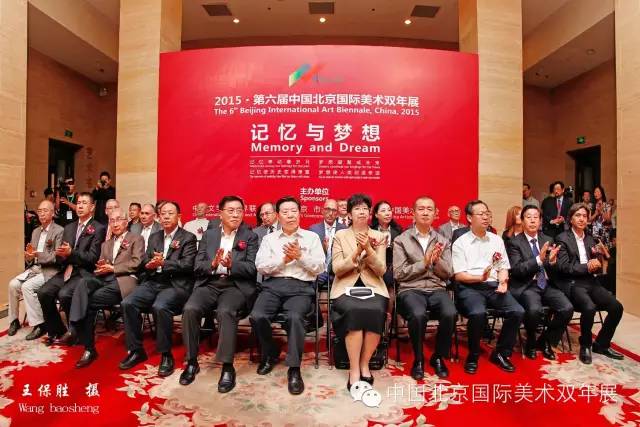
More than half of the member countries of the United Nations participate in the 6th Beijing Biennale with the theme of Memory and Dream
Autumn is the best season in Beijing. During this autumn from Sep.24 to Oct.15, 2015, the 6th Beijing Biennale co-sponsored by the China Federation of Literary and Art Circles, the People’s Government of Beijing Municipality and the China Artists Association was exhibited in the National Art Museum of China. The exhibition attracted 685 pieces of artwork from 96 countries (188 pieces of artwork from China, 497 pieces of artwork from foreign countries). The International Art Gala with unprecedented size of participating countries enriched the magnificent scenery of autumn in Beijing.
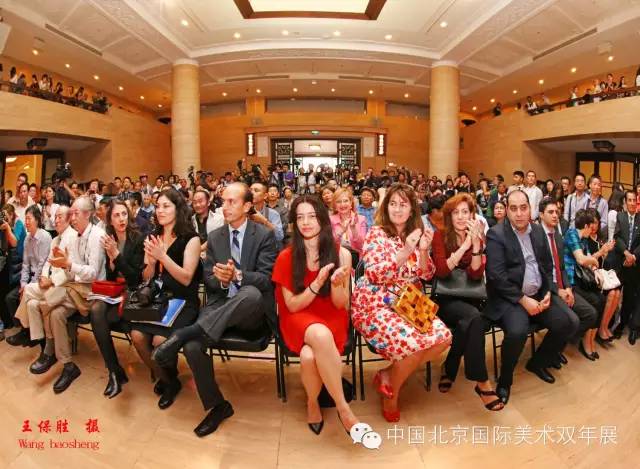
Compared with the 1st Beijing Biennale in 2003, the participating countries has been doubled, increasing from 45 to 96 and the comprehensive artistic standard surpassed previous Beijing Biennales. After the theme was published in January, 2014, 6,650 artists from 103countries and regions submitted 18,386 artworks, making this year’s Biennale the largest ever. Artists from China including Hong Kong, Macao and Taiwan, the US, France, Egypt, India, Indonesia, Greece and Romania showed the most enthusiasm. All these show that Beijing Biennale has become an international platform for cultural and artistic exchange and a center to exhibit the global contemporary paintings and sculptures. Due to the success of our past five Biennales, the principle, theme, evaluation system and organization of the Beijing Biennale have all been well-received by artists worldwide. More and more painters and sculptors want to participate into the Beijing Biennale.
The theme of the 6th Beijing Biennale is “Memory and Dream”. The memory is the inscription on people’s hearts, accumulation of the history, treasure house of the spirit and space to be explored by art. Dreams are beautiful ideals of people, hopes which put an end to disasters, visions for pursuing happiness and goals which call for relentless efforts.
People in every country in the world have their unique memories and dreams among which the most important memory is the memory about history and culture and the most important dream is the dream about life and society. Memories extend histories and are conducive to form the cultural features while dreams enrich lives and are conducive to promote social development. The time-honored historical and cultural memory of the Chinese nation is as rich and precious as that of other nations in the world. All nations can communicate with each other and share their unique experience and spirit.
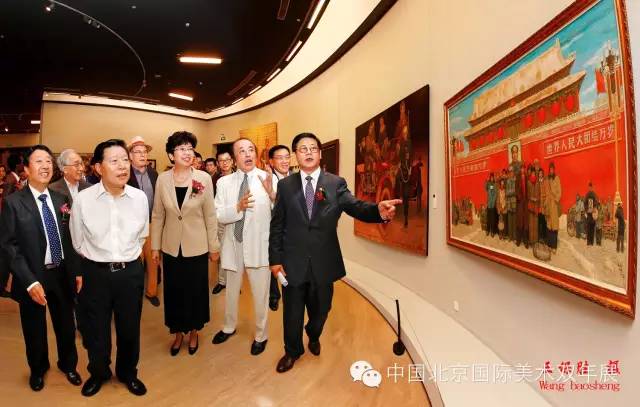
To achieve the Chinese Dream of realizing the great rejuvenation of the Chinese nation and the dream of peaceful development and win-win cooperation between different countries in the world is the shared goal of all human beings. The dream stimulates the vitality of us to create miracles and a bright future. Memories belong to the past while dreams embrace the future. Memories and dreams combine history and reality, connect the past with the future. Artists are recorders of the history and dream catchers of the future.
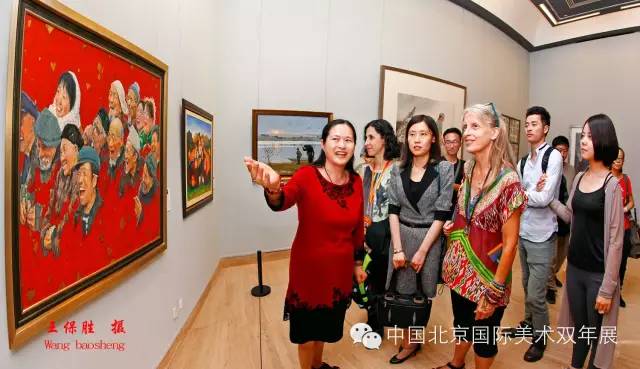
The theme of “Memory and Dream” fully reflects the humanistic care of artists, arouse their passion to paint and give full play to their aesthetic imagination so that they can create art works that are as lasting as memories and as magical as dreams.
Just as the interpretation of the theme of “Memory and Dream” from an Italian: “Italy has a long-standing history as China. Both memories and dreams are very important to us. The theme is highly relevant to artists and others.” The international symposium attracted theorists and artists from home and abroad to conduct a comprehensive communication and deep discussion on the theme of“Memory and Dream”during the Beijing Biennale.
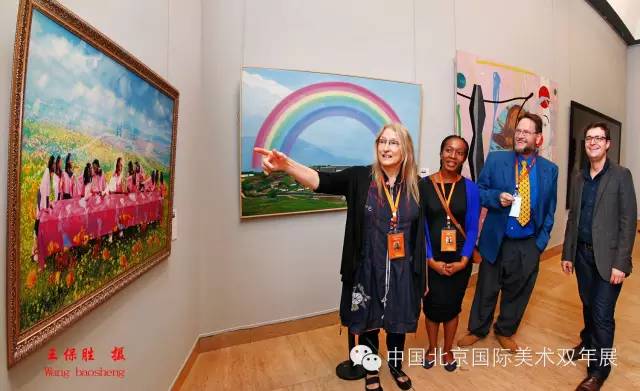
Most of the artists from all of the participating nations in the theme exhibition this year consciously created their works closely on the theme of “Memory and Dream”. Since 2015 happens to be the 70th anniversary of the victory of the Chinese People’s War of Resistance against Japanese Aggression and the World Anti-Fascist War, many participating works show the memories of the war and the dream for peace which also warn that the world is not peaceful even today.
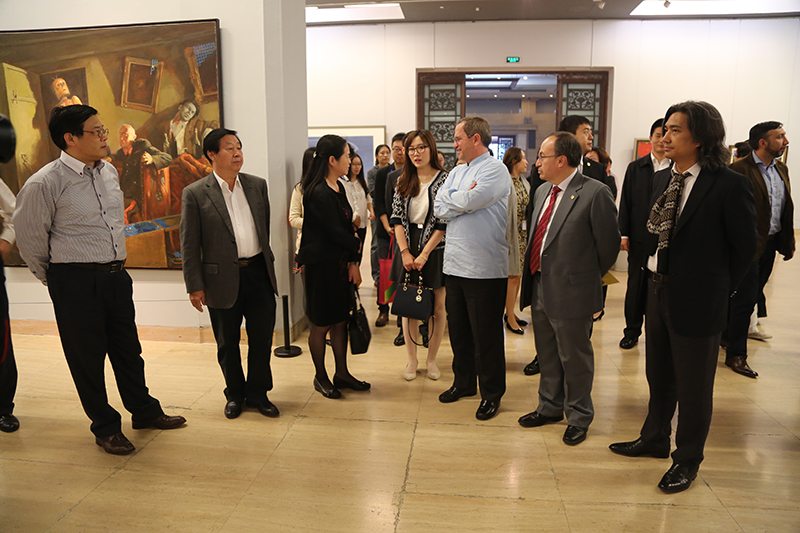
A mass of domestic and foreign participating pieces coincidentally focus on the memory of childhood and the homeland or the fragments of memory to exhibit their personal dreams, national dreams and human dreams and are tinged with the powerful emotions of the artists. Emotional memory is deeper and firmer than other memories. When individual emotional memories and dreams integrate with those of the nation and mankind, such artistic works are easier to arouse the viewers’ emotional resonance and aesthetic association.
When the participating artists interpret the theme of “Memory and Dream”, they display their diverse artistic styles, conduct personalized artistic exploration, continue to tap the potentials to transform paintings and sculptures from the traditional modes to the modern ones and infill more humanistic spirits into other artistic features like installations, images and mixed media. The diverse artistic styles of the participating pieces include classic, modern and contemporary artistic expressions. Some are realistic or surrealistic while others are abstract or even purely abstract. Nonetheless, most of the artworks are between realistic and abstract and are similar to the principle of“ingenuity between similarity and dissimilarity”advocated by Qi Baishi, a modern Chinese painter.
Although the memory of the past and the dream for the future are imaginary, they are the realistic feelings based on the present. Consequently, many artistic works themed on “Memory and Dream” usually combine the surrealistic romantic illusion with the true feelings of the realistic life to create dreams that are both real and magical and bring us completely fresh aesthetic experiences.
Such diverse artistic works in effect reflect the unique historical and cultural memory as well as the traditional artistic characteristics of all the countries and provide the valuable first-hand image data for the Chinese and foreign artists to conduct direct exchanges and dialogues and learn from others’ strongpoint through the platform of the Beijing International Art Biennale.
In addition to the theme exhibition, the enthusiasm to participate in the special exhibitions surpassed previous ones. There were six special exhibitions, namely, “the Special Exhibition of Contemporary Art of Southeast Asia”, “the Special Exhibition of Contemporary Art of Ecuador”, “the Special Exhibition of Contemporary Art of Canada”, “the Special Exhibition of Contemporary Art of South Africa”“the Special Exhibition of Contemporary Art of Armenia”, , and “the Special Exhibition of Contemporary Art of Chile”, covering the contemporary art of the countries in Asia, Africa, North America and Latin America. Such special exhibitions echo with the theme of “Memory and Dream”, display the traditional artistic characteristics and contemporary artistic exploration of the participating countries and add brilliance to the present splendor of the 6th Beijing International Art Biennale, China, 2015.
Many distinguished guests attended the opening ceremony and visitors of the National Art Museum of China attained a new height.
At 10 o’clock on the morning of Sep. 24, the 6th Beijing Biennale held its opening ceremony. Distinguished guests attending the opening ceremony included Mr. Sun Jiazheng, former vice Chairman of the National Committee of the Chinese People’s Political Consultative Conference and president of the China Federation of Literary and Art Circles, Ms. Zhao Shi, Vice Executive President of the China Federation of Literary and Art Circles, Mr. Lin Jun, Chairman of the All-China Federation of Returned Overseas Chinese, Mr. Li Wei, Member of the Standing Committee of CPC Beijing Municipal Committee and Director of the Publicity Department, Mr. Xia Chao, Vice President of the China Federation of Literary and Art Circles, Mr. Chen Jianwen, Secretary of Secretariat of the Central Committee of China Federation of Literary and Art Circles, Mr. Jin Shangyi, member of the Standing Committee of the Chinese people’s political consultative conference and Honorary Chairman of the China Artists Association, Mr. Liu Dawei, Vice President of the China Federation of Literary and Art Circles and Chairman of the China Artists Association, Mr. Sun Linjiang, Director-General of the Administrative Department of Ministry of Foreign Affairs of the People’s Republic of China, Mr. Wu Zhipan, Vice President of Peking University, Ms. Li Xiaohong, Deputy Inspector of Literature and Art Bureau under Publicity Department of the Communist Party of China, Mr. Wu Weishan, Director of the National Art Museum of China and vice chairman of the China Artists Association, Mr. Shao Dazhen, Counselor of the Curatorial Committee of the Beijing Biennale and the host-of-chief of the symposium of the Beijing Biennale,Mr. He Jiaying, Vice Chairman of the China Artists Association, Mr. Zeng Chenggang, Vice Chairman of the China Artists Association, Mr. Xu Li, Secretary General of the China Artists Association, Ms. Tao Qin, Deputy Secretary General of the China Artists Association, Mr. Du Jun, Deputy Secretary General of the China Artists Association, Mr. Ma Shulin, Executive deputy director of the National Art Museum of China, Mr. Chen Dong, Director General of the Beijing Municipal Bureau of Culture.
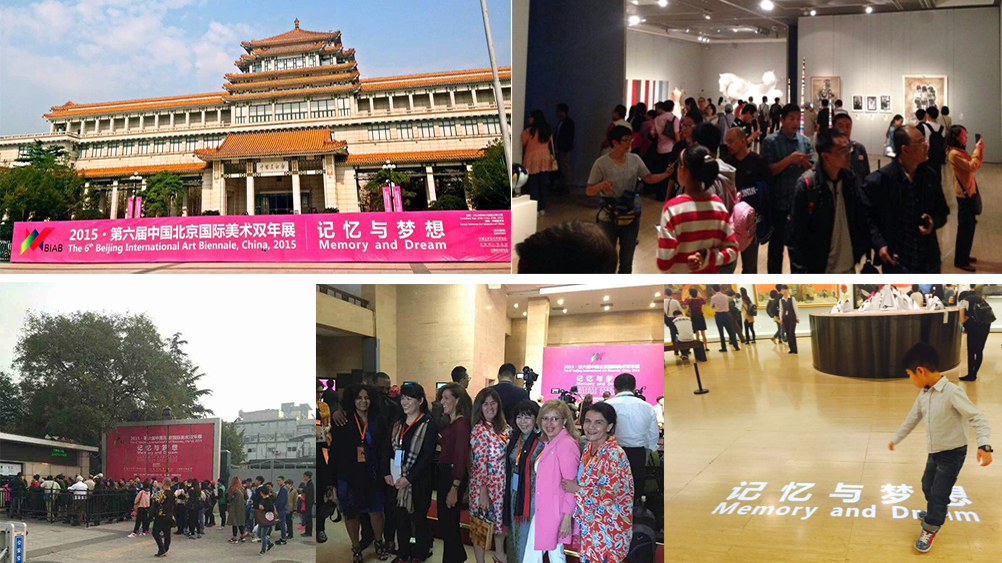
Ambassadors from participating countries present at the opening ceremony included Mr. Kujtim Xhani, Albanian Ambassador to China, Mr. Plamen Shukyurliev, Bulgarian Ambassador to China, Mr. Jorge Heine, Chilean Ambassador to China, Mr. José M. Borja L., Ecuadorian Ambassador to China, Mr. Vassilios Costis, Greek Ambassador to China, Ms. Baktygulova Kanayim, Kyrgyz Ambassador to China, Mr. Doru Costea, Romanian Ambassador to China, Mr. Frantisek Dlhopolcek,Slovakian Ambassador to China and Ms. Cindy Termorshuizen, Deputy Canadian Ambassador to China. And officials for culture affairs from about 20 embassies including Armenia, Azerbaijan, Belarus, Belgium, Columbia, Egypt, Hungary, Indonesia, Israel, Kazakhstan,Latvia,Lebanon, Lithuania,Mexico,Montenegro, Netherlands,Norway, Russia, Serbia and Sri Lanka also attended the opening ceremony, which registered the largest number of guests of honor. Their enthusiasm expressed their close attention to the exhibition. More than 200 artists from 75 participating countries (which registered 78% of the all participating countries), covering 5 continents across the globe, curators of the Beijing Biennale and representatives of selected Chinese artists also got together at the opening ceremony. The number of foreign guests presented at a single exhibition at the National Art Museum of China outnumbered all the previous ones.
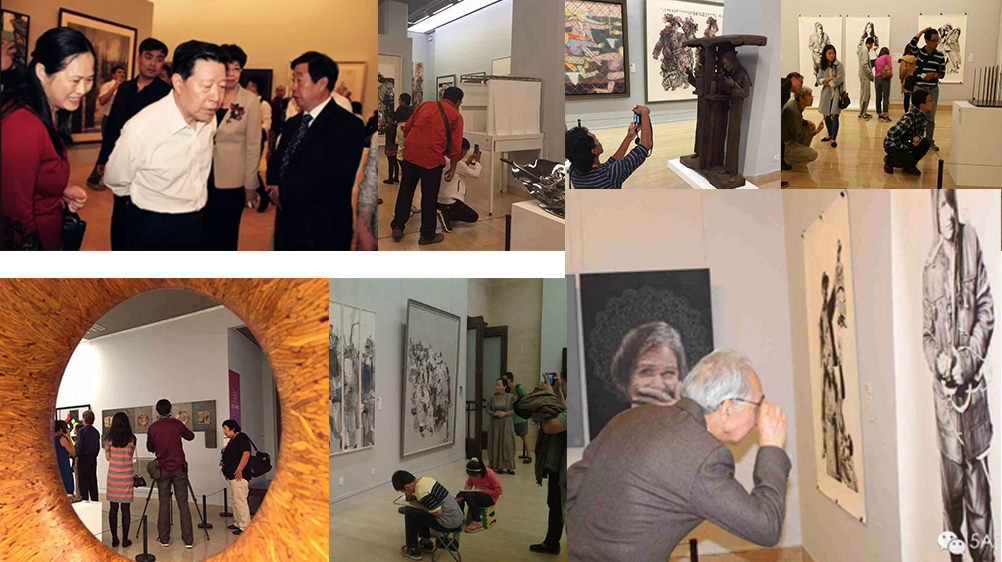
The opening ceremony is hosted by Mr. Xuli, Secretary General of the China Artists Association. Ms. Zhao Shi, Vice Executive President of the China Federation of Literary and Art Circles, Mr. Li Wei, Director of the Publicity Department of Beijing Municipal Committee, Mr. Liu Dawei, Chairman of the China Artists Association and Ms. Cindy Termorshuizen, Deputy Canadian Ambassador to China delivered a speech at the opening ceremony.
Excerpt from the speech of Ms. Zhao Shi is as follows: “As a kind of plastic arts, fine art vividly embodies the history, culture and aesthetic appreciation of nations. And it is essential for the development of human civilization. Since the appearance of prehistoric cave paintings and the earliest sculpture "Venus of Willendorf", paintings and sculptures have been carriers of human memories and dreams, showing us the world’s history of painting, sculpture and culture in a detailed manner. The Beijing International Art Biennale is like a colorful and extending scroll unveiling diverse contemporary painting and sculpture works with unique beauty across the world.
As a permanent international art exhibition project under the China Federation of Literary and Art Circles, the Beijing International Art Biennale has offered a fascinating insight into the world of visual arts since its founding. In the past decade, the themes of the exhibition covers “Originality: Contemporaneity and Locality”, “Humanistic Concern of Contemporary Art”, “Colors and the Olympics”, “Environmental Concern and Human Existence” and “Future and Reality”. With distinct spiritual content and profound humanistic concern, the Beijing International Art Biennale has attracted first-class art works from all over the world and received wide recognition and active participation from domestic and foreign artists. The Beijing Biennale not only opens a window for presenting the spirit of Chinese culture and reflecting Chinese people’s aesthetic pursuit, but also builds a platform for us to learn excellent cultural achievements from others. It also creates a broad space for promoting culture and art exchanges and protecting diversity of world culture.
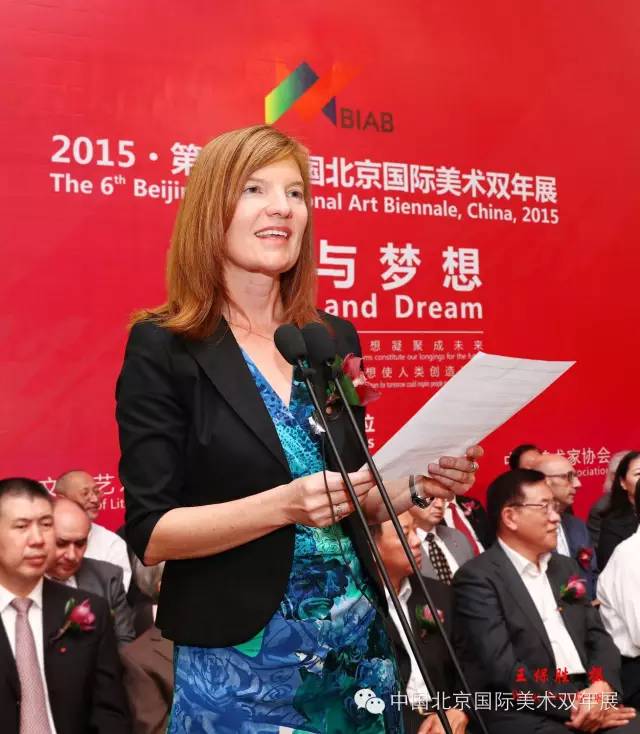
The 6th Beijing Biennale will present paintings and sculptures that engraved memories and dreams of humankind, which is both contemporary artists’ social responsibility of promoting and inheriting the fine history and culture and their vivid expression of creating and pursuing dreams. The 6th Beijing Biennale attracts almost 700 pieces of artwork of more than 600 artists from 96 countries, presenting their unique interpretation of historical and cultural memories and their internal perception and artistic achievements of participating artists from different nations. It is thought to be an international art gala.
As peace and development has become the theme of the present era, the changes of the international community have gradually become the common destiny of human beings. “The world will be a harmonious place if people appreciate their own beauty and that of others, and work together to create beauty in the world”. Artists should respect civilizations of different countries and nations, promote each other’s fine culture, communicate with and learn from each other, and build a common spiritual homeland for human beings. It has become the common expectation of people and artists of the world and one of the principles that contemporary international cultural exchanges should stick to. We wish that this exhibition will let the appeal of art overcome the obstacle of time, space and national boundaries and exhibit the achievements of the innovative development of international art circle and good environment of international exchange and cooperation. It is also expected to present the artistic proposition of Beijing International Art Biennale to establish a harmonious world and respect cultural diversity, and demonstrate the long-standing and profound Chinese culture as well as the vigorous pursuit of Chinese Dream by contemporary Chinese people. It will also further strengthen cooperation and friendship among international art circles and make new contributions to the prosperity of world art and progress of human civilization.”
In the speech of Mr. Li Wei, he stressed that: Under the philosophy of promoting the contemporary paintings and sculptures, it has inspired the passion, imagination and genius of numerous artists since the first Beijing International Art Biennale in 2003. During the past decade, nearly 2000 artists from over 100 countries have attended the past five Biennales and more than 3000 artworks have been displayed, making the Beijing Biennale an internationally well-received platform for artists and cultural exchanges. With its growing brand effect, it has become an international art gala with Chinese characteristics. We will take the 6th Beijing Biennale as an opportunity to make full use of our advantage, grasp the development opportunity and create a good environment with the guidance and help from the central government and the support and participation from international friends and artists. In this way, we will contribute to the prosperous development of fine arts and exchanges between Chinese and foreign artists.
On behalf of the organizing committee, Mr. Liu Dawei expressed thanks for everything that the Embassies of participating countries have done to help communicating with artists. He said: “The number of participating countries and art works and the lengths the exhibition space and the duration of exhibition this year all surpassed previous ones. The 6th Beijing Biennale attracts 96 countries which registered half of the member countries of the United Nations. About 700 pieces of artwork from over 600 artists will be exhibited at the National Art Museum of China for nearly a month. The theme “Memory and Dream” deeply expresses the humanistic concerns of contemporary artists and explored the vast space of their dream of art. And so today we can enjoy these works that are as profound as their memories and as magical as their dreams. We really appreciate the active contributions of nearly 7000 artists from hundreds of countries.
As an international representative, Ms. Cindy Termorshuizen, Deputy Canadian Ambassador to China delivered a speech in both Chinese and English. Excerpt from her speech is as follows: The year of 2015 marks an important achievement for our two countries as we celebrate the 45th anniversary of bilateral diplomatic relations. And it is another special milestone with 2015-2016 being the Canada-China year of people-to-people and cultural exchange. I believe that Canada’s presence at the Beijing Biennale is a wonderful expression of our commitment to deepen all aspects of the Canada-China relationship, which continues to expand year-on-year. Cultural exchanges – in the visual arts, performing arts, literature, and film – are a key and growing part of our ties and offer many Chinese their first impressions of Canada and, of course, the other way around. Going forward, I think we can expect to see more and more Canadian art here. Canada is committed to growing cultural cooperation and exchanges with China, as well as strong personal relationships, which, in turn, will serve to deepen our mutual understanding and prosperity.
In the afternoon of Sep.25, 2015, the Montenegrin ambassador to China who missed the opening ceremony especially paid a visit to the National Art Museum of China and enjoyed the Beijing Biennale for one hour and a half. The Ecuador Embassy in China presented the Catalogue of the 6th Beijing Biennale to the President of Ecuador in a timely manner. During an interview on Sep. 30, Mr. José M. Borja L., the Ecuadorian Ambassador to China expressed that the Special Exhibition of Contemporary Art of Ecuador in the 6th Beijing Biennale provides a perfect platform for cultural exchange and communication between China and Ecuador. As a fine art center in Latin America, Ecuador shows confidence in organizing the Special Exhibition which represents the highest level of Ecuador and strengthens the artistic features of Latin America. In the afternoon of Oct. 7, Minister of Foreign Affairs and Human Mobility of the Republic of Ecuador Ricardo Armando Patino Aroca paid a visit of the 6th Beijing Biennale at the National Art Museum of China immediately after he got off the plane.
In the morning of Oct. 9, Mr. Huang Kunming, Deputy Minister of the Publicity Department of the Communist Party of China and Director of the Civilization Office of the Central Communist Party Committee and Mr. Liu Qi, former member of Political Bureau of the CPC Central Committee, President of the China Volunteer Service Federation and former Secretary of the CPC Beijing Municipal Committee paid a visit of the 6th Beijing Biennale and enjoyed the artworks of the selected artists from home and abroad and six special exhibitions on the first floor of the National Art Museum of China. When they appreciated these artworks which are of different features and subjects from different countries, they were in high spirits and stopped in front of several artworks to discuss with others about the conception, content, style and texture and showed their satisfaction. Mr. Huang Kunming, Deputy Minister of the Publicity Department of the Communist Party of China said that the Beijing Biennale deserves extensive coverage by the Xinhua News Agency, the CCTV and other news media as it attracts artists from 96 countries to participate and the artworks covers a wide range.
In the morning of Oct. 12, a delegation from Hong Kong led by Mr. Raymond TAM Chi-yuen, Secretary for Constitutional and Mainland Affairs especially visited the exhibition at the company of the Ministry of Foreign Affairs of the Hong Kong Special Administrative Region and they specially expressed their appreciation and approval for the selection of artists from Hong Kong.
In the afternoon of Oct.14, Mr. Liu Qibao, member of Political Bureau of the CPC Central Committee, Secretary of the Secretariat of the CPC Central Committee, Minister of the Publicity Department of the Communist Party of China paid a visit to the 6th Beijing Biennale at the company of Mr. Huang Kunming, Deputy Minister of the Publicity Department of the Communist Party of China and Director of the Civilization Office of the Central Communist Party Committee, Ms. Zhao Shi, Secretary of Leading Party Member’s Group of the China Federation of Literary and Art Circles, Mr. Jing Junhai, Deputy Minister of the Publicity Department of the Communist Party of China, Mr. Li Yi, Vice Chairman of the China Federation of Literary and Art Circles, Mr. Zuo Zhongyi, Vice Chairman of the China Federation of Literary and Art Circles, Mr. Liu Dawei, Chairman of the China Artists Association and Vice Chairman of the China Federation of Literary and Art Circles, Mr. Wu Weishan, Director of the National Art Museum of China and Vice Chairman of the China Artists Association, Mr. Xuli, Secretary General of the China Artists Association, Ms. Tao Qin, Vice Secretary General of the China Artists Association, Mr. Wang Haiping, Deputy Minister of Publicity Department of the CPC Beijing Municipal Committee and Mr. Chen Dong, Director General of the Beijing Municipal Bureau of Culture. When Mr. Liu Qibao, Minister of the Publicity Department of the Communist Party of China appreciated artworks from Chinese and foreign artists, he stopped and asked questions from different perspectives for several times. After discussions with others, he praised the success of the 6th Beijing Biennale and spoke highly of the scale, academic orientation and details of the exhibition display.
Since the opening ceremony of the 6th Beijing Biennale, average daily amount of audience is close to 10.000, which showcases their enthusiasm. The total number of audiences amounted to 200,000 during the exhibition, which marked a new high in terms of the number of audience of a single exhibition at the National Art Museum of China in the year of 2015. Over 1,000 feedback forms were randomly distributed among guests of the 6th Beijing Biennale and based on the hundreds of submitted feedback forms, nearly 100 percent of them showed satisfaction. Here is part of the comments from audiences:
“The exhibition is helpful to let people better educated, enriches the spiritual life of the nation and is conducive to reshape the national spirit. The exhibition provides artworks of different styles and broads the horizon of the general public, especially those teenagers.”
“Our country is now powerful and the general public has a great sense of pride. It feasts our eyes. We hope that it can be held once a year.”
“Beijing Biennale is an international exhibition. Artists from a large number of countries participated in the exhibition for every session. These artworks broads our horizon and presents the new trend of the international artistic community. It is significant for us Chinese audiences.”
“The exhibition is wonderful as it provides human-oriented services and has a reasonable display of artworks. The exhibition takes advantages of the modern high technology and an international curatorial committee.”
“The exhibition enriches the spiritual life of the general public and it is helpful to improve our artistic accomplishment. It is wonderful that we can appreciate artworks from all over the world without going abroad. ”
“The exhibition is so inclusive that artists from all over the globe can tap their potential to make creation. The theme of “Memory and Dream” embodies the common appeal of the humankind. We live in one world and art from different places has its own splendor and is all great. Excellent works always have the same artistic appeal. It is just like that although memories and dreams of different people are different from each other, all ends in the same destination. The exhibition leaves us a good memory and provides us dreams and imaginations.”
The 6th Beijing Biennale displays artists’ perception of “Memory and Dream” and illustrates artistic landscapes of different countries and colorful dreams concerning all human beings.
In caption of the selected work Memory and Dream, a French artist Barthelemy Chantal Andrea wrote: “Today memory and dream make her serene and she savors this moment of emotion towards this transition symbolized by the footbridge on which she visualizes going towards her ideal. She is in peace with herself.”
In caption of the selected work The Helmet,a Greek artist Nikolaos M. Bokeas wrote: “The painting is about the face of the ancient hero of Thermopiles and his sacrifice. Here we can see a Holy Grail at the hands of the modern man. The memory engraved on the rusted helmet. The memory engraved on the wrinkled face of the man of creativity and peace. The hands hold the dream of every human existence through the ages, the dream of freedom, the dream of raising their children, to farm the land, to create and to sing freely. Cultures that forget their history will die. ”
In caption of the selected work Gift, an Iranian artist Fatemeh Mofarahi wrote: “Artists with paint, brushes, creativity and new ideas can be one of the pioneers in pursuing peace and friendship in the world, which is a precious gift of God to human to grow. Only by proper use of these gifts to strengthen dialogue with people from different countries, to seek global peace, friendship and empathy can move and rotate the world…All this invites people to arrive at reconciliation and strive for the common objective. ”
In caption of the selected work Lady Churchill Cigar,an American artist Laurin McCracken wrote: “This is a collection of old canning jars and tins from the turn of the century. The jars were used to put away fruits and vegetables for the winter. Commercial goods came in the tin can keep them safe. The painting is meant to create a feeling of memory and nostalgia of long time ago. The title is from the lettering on of the tins. ”
In caption of the selected work Ghetto Child, an Australian artist Anastasia Contoguris wrote: “The artist created a statue of a starving child huddled on a stool in the Warsaw Ghetto and begged for a morsel of food. Over one million Jewish children were innocent victims of the Holocaust. In the midst of such horrors, they dreamt of a safe world and the warmth and safety of their parents’ arms. The memories of these unfilled dreams remain with us to this day. The artist imbued the artwork with hopes and dreams for a better tomorrow.”
In caption of the selected work Long Night, Guo Runwen, a Chinese artist wrote: “The painter applied a realistic painting technique to depict a young soldier of the former Soviet Red Army that delivered gigantic contributions to the resistance against Fascism and left the Chinese people with an indelible memory. The year 2015 is the 70th anniversary of the victory of the World Anti-Fascist War. The painting is the review of that memory and bears the painter’s wish for permanent world peace. ”
In the caption of the selected work Spoils in the Liberated Areas, a young Chinese sculptor GengYanmin wrote: “This work is a description and expression of triumphant atmosphere after the war of liberation. The smile on children’s faces is in sharp contrast with tanks and other weapons of the war. It is satire of war and an ode to peace. This memory is a shared memory of the Chinese people. Even though today we are in peace, mankind should still take history as a mirror to maintain the hard-won peace.”
In caption of the selected work Late Repentance, Wang Zijiang, a Chinese artist living in Japan wrote: “The elderly veteran portrayed in the work is named Sakamoto Junichi, whom the author encountered in Shimane Prefecture, Japan. The work was created to commemorate the war’s deceased and to pray for eternal world peace.”
In caption of the selected work Monument, a Chinese artist Wu Yanzhen wrote: “At the time of the 70th anniversary of the victory of the World Anti-Fascist War, cherishing the reflection on fascism’s terrible effects on humans and the commemoration of Chinese people’s anti-fascist efforts, the artist adopts the technique of realistic sketch of historical photos of anti-Japanese war, accumulating the 81 sketch photos in a way of monument to express the expectation of world peace and development in the future. ”
In caption of the selected work Salute to the Master, a Chinese painting artist Liu Yiqing worte: “On the occasion of the 70th anniversary of the victory of the World Anti-Fascist War in 2015, the painting takes Guernica of Picasso and The Refugees Figure of Jiang Zhaohe as the background in memory of the predecessors, records the disasters of wars to the civilians and the accusal of Fascism in a unique way, and warns the people to bear in mind history and love the hard-won peace.”
In caption of the selected work The Soul of the TaklaMakan Desert—The Twelve Muqam, a Chinese painting artist Liu Xuanrang wrote:“The painter adopted the grand narrative approach to draw a large painting through which a nation is narrating its own history. Taking the yellow sand as the basic tone, the shot was lengthened to the ancient past when dozens s of people were in the desert. The Twelve Muqam, an intangible world heritage, was the basic conception of the painting and fixed the images and motions of the characters to the moment of a group of artisans singing the Twelve Muqam. The abundant and vivid characters and the compact composition of the picture as well as the background of the mirage-like ruins of the ancient city in the desert, the populous diversifolia, the remains of the cattle and sheep, and the quick sand present to us the changing history of the nation.”
In caption of the selected work Autumn Scenery beyond the Great Wall,an Chinese oil painting artist Wang Hongjian wrote: “The painting depicts the scene of a farmer family beyond the Great Wall in northern China as they harvest potatoes in Autumn. The painter adopted the composition and hues of traditional Chinese painting to control the artistic conception of the picture, and applied the representation skill of Western painting to show the images of the farmers and the scenery beyond the Great Wall. He integrated the sunny autumn and images of the kind, self-contained, and joyful farmers as well as the desolate scenery in the area to the north of the Great Wall.”
Contemporary paintings and sculptures: a carnival for artists from all over the world
Since its foundation in 2003, the Beijing Biennale has showcased contemporary paintings and sculptures from all over the world. As an event recognized by artists globally and the largest platform in Beijing of its kind, the Beijing Biennale created its unique systems and principles. More than 200 artists attended the opening ceremony, seminars and other activities of the 6th Beijing Biennale, 2015, with half of them coming to China for the first time. The artists speak different languages, have different skin colors and religious beliefs, but they share a common love of paintings and sculptures. The Beijing Biennale provided an opportunity for them to appreciate 700 paintings and sculptures from different countries, to communicate with other artists and to get a firsthand taste of the passion of the Chinese people.
Participating artists from foreign countries all express their highly praise for the Beijing Biennale and for China:
Fiona Stanbury from Britain said: “It is the best exhibition I have ever seen-the variety of styles and ideas was very wide and rich, and the paintings were hung so beautifully. I felt very honored to be part of it and to meet artists from many countries. This exchange is very beneficial to all artists because it makes us challenge our ideas and vision, and I learned many things. Also I was very lucky because I met Chinese artists and learned much from them about Chinese art and also about your wonderful country! Many thanks also to the Committee of the Biennale for making this Biennale so perfect, and for helping artists to learn about each other’s work and cultures. This precious information and the friendship will help us share art ideas and vision and it will benefit our own cultures.”
Gabriel Martinez from France said: “Before, the dream has a name—Peking with the Biennale.”
Ioannis Bardis from Greece said: “I would like to thank you to choose my work to stay in a museum in Beijing. I appreciate it. I want to thank you for the hospitality of the Committee. It is perfect. The artworks presentation is also perfect. The symposium gives us an opportunity to learn new things about art. The future of art there is in China and the Biennale connects artists from different countries.”
Jorge Perugachy from Ecuador said: “I would like to return to this beautiful and ancient country that with your art it becomes my second country. I will always bring to this country the best of me and my colors.”
José Luis Arbulú from Peru said: “I think the Biennale should be one strong exchange between Chinese artists and foreign artists, search more contact links. I believe the symposium is a very important space for exchange and create links.”
Lena Kelekian from Lebanon said: “I would like to congratulate the organizing committee of the Beijing Biennale for it is very successful as always. I consider the BIAB the backbone of all Biennales as it is unlike many other biennales including the Venice Biennale. It is my 8th time coming to Beijing and I enjoy every minute in this historic city. I Hope to come for the next Biennale.”
Peintner Elmar Anton from Austria said: “It is a good idea that Beijing International Art Biennale gives each biennale a new theme. It is very special of the Beijing Biennale to gather artists from all over the world and let artists communicate with each other. The world becomes smaller. I would like to extend many thanks to the organizer. Please continue!”
Masja Pakvis from Netherlands said: “All compliments.”
The most representative feedback from artists is the one from Nguyen Mai Huong, a selected artist from Viet Nam: “The Beijing Biennale is one of the world’s most famous and highly qualified Biennale. Beijing Biennale is a large-scale international art exhibition where all the most creative artists can gather to express their ideas and abilities. It is a great opportunity to show China’s hospitality and its great art history and colorful culture. The purpose of the Beijing Biennale is to connect the artists from generations to generations to develop arts. The 6th Beijing Biennale with its theme “Memory and Dream” is a great event that links history with reality, connects the past and the future, and could be best placed to reflect the humanistic care of artists, arouses their passion to paint and inspire artists’ aesthetic imagination. In addition, I would like to emphasize that the Beijing Biennale is a featured exhibition, it is different from the rest major Biennales of the world. The Beijing Biennale is a large-scale international art exhibition, really qualified with high standards. With the great topic “Memory and Dream”, it emphasizes the unique form of contemporary painting and sculpture. The Beijing Biennale really has international influences on many aspects: the art market, the cooperation between different countries, the development of each individual artist, etc. They all come to share the dream of partnerships and long-term developments between different countries. The Beijing Biennale helps us all to head to a bright future, where all our dreams can come true.”
The international academic symposium provides a platform where artists from different countries can exchange their ideas freely
The international academic symposiums are arranged at every session of the Beijing Biennale. This year, the “International Symposium of the 6th Beijing Biennale” was set on September 25th at the Beijing International Hotel. Mr. Liu Dawei, Chairman of the China Artists Association delivered a speech at the symposium.
Mr. Shao Dazhen, Honorary Director of the Commission on Art Theory of the China Artists Association and Professor of the Central Academy of Fine Arts acted as the host-of- chief of the symposium along with Ms. Tao Qin, Vice Secretary General of the China Artists Association, Mr. Wang Yong, Research Scholar of the Chinese National Academy of Arts, Mr. Zhang Xiaoling, Vice President of the China National Academy of Painting and Mr. Ding Ning, Vice Dean at the School of Arts of the Peking University hosting parallel sessions.
The symposium invited around 20 theorists and artists from home and abroad to deliver a speech on the theme of “Memory and Dream”. They all expressed their opinions and conducted a comprehensive discussion on contemporary art, the context of art creation, multiculturalism and the system of the Beijing Biennale. Over 200 people covering artists from all over the world, representatives from art institutions and media attended the symposium.
The theme of this symposium boasts strong realistic pertinence and general applicability, which provided an opportunity for all the attendees to communicate and exchange their ideas. The symposium can be taken as an example in this year’s international academic activities in the art community as a result of its professionalism, concentration and pervasiveness.
At the first section of the symposium, Mr. Shao Dazhen generally introduced the 6th Beijing Biennale and mentioned that the artistic standard of this session was improved steadily compared with previous ones. Beijing Biennale sticks to take as contemporary paintings and sculptures as the main contents of its exhibition and accept a small number of installations, videos, mixed media and other new media art, which make it a unique Biennale.
Then, Mr. Liu Dawei made a deep interpretation of the theme of the academic symposium. He pointed that: “The theme of “Memory and Dream” is inclusive and easy to perform. When artists make art creation, the theme extends a vast space for their imagination. Besides, the theme coincides with the “Chinese Dream”.
In the personal statement section, nearly all speeches focused on the interpretation and understanding of the theme. Peter Hiers from America said: “There is a common ideology called “the American Dream” in which the pursuit of material success is the path to fulfillment and self-worth. However, Depletion and degradation of our survival resources has dire consequences. I hope equilibrium can be achieved between what we take from and what we renew with our life-sustaining resources.” Shang Hui, Executive Chief Editor of Art Magazine by China Artists Association said: “Chinese indigenous art education, art creation, and art concepts still uphold Chinese painting, oil painting, prints, watercolor paintings, lacquer paintings, ceramic crafts and sculptures. Chinese artists neither think that “the end of easel painting has come” nor lose confidence in the sustainable development of easel painting. Rémy Aron, President of France Artists Association said: “ All artists are trying to exhaust resources in their paintings, and look for the relationship and correspondence between shape and color, and the rhythm in the limited palette with their profound, strong and organized desire. As a messenger between memory and dream, the artists wish to present a harmonious space at some time in the future.” Zheng Gong, Vice Director of the Research Institute of Art under the Chinese National Academy of Arts said: “Chinese contemporary experimental is now 30 years old. There is no doubt that Chinese contemporary experimental art has been influenced by western contemporary art, but more importantly, it highlights Chinese problems and values Chinese cultural elements. These artists express their concerns with reality through sensitivity and intelligence. Their works, which feature being conceptual and visually influential, are thought-provoking. The specialty of contemporary experimental art in illustrating different kinds of special relations plays a significant role in the development of Chinese contemporary art.” Battur Tsedenpil, Painting Teacher of the School of Fine Arts, Mongolian State University of Arts and Culture said: “The main content of my speech shows how nomadic Mongolians inhabit in the city, how artists worry about that issue and why artists aspire to the nature…No one can imagine that what level of spectacular humankind can reach in thousands or billions of years with their “dream” and “aspiration” to the dream. I worry about that my, your or our culture, legacy, native customs and nature will fade into this limitless time and expansion. That’s why I always put aspiration into my art work to give a message to everybody that we have to keep our culture, legacy and nature, no matter what nationality we are.”
In the free speech section, all the guests present at the symposium were enthusiastic to make a speech which covered a wide range of topics. They all expressed their heartfelt feelings, evaluations and advices about the Beijing Biennale. Mr. Shao Dazhen, the host-of-chief pointed that: it is a wise choice and holy responsibility for all the contemporary artists to eliminate disasters and rebuild the foundation for the road to the future. Artists from all over the world are expected to create characteristic artworks featuring romantic sentiment and splendid dreams on the platform of the Beijing Biennale. Wonderful artworks can go beyond the boundaries to connect all the people together and express their common aspiration of peaceful development and win-win cooperation.
Hundreds of news media report on the event on a timely basis
During the exhibition, over hundreds of news media from home and abroad include the People’s Daily, the Xinhua News Agency, the Guangming Daily, CNR (China National Radio), CCTV, CRI (China Radio International), the China Daily, the Worker’s Daily, the China Youth Daily, the China News Agency, China Culture Daily, China Art News, Beijing TV, SHPD, the Beijing Daily, the Beijing Youth Daily, Art, China Art, Peoples Network, Sina.com, Sohu.com, China Photo Service, BBC, Reuters, European Pressphoto Agency, Yahoo, Prensa Latina, the Latin American News Agency, PR Newswire, The Boston Globe, Singapore Lianhe Zaobao, Hindustan Times, YouTube, Euronews, Wall Street Select and Huaren News report on the duration, scale, artworks, venue, artists, curators, organizing committee and its significance of the Beijing Biennale in real time. Among those reports, the China Daily, the Guangming Daily, China Culture Daily, China Art News especially made a full page report. The China Central Television’s (CCTV) national news program “Xinwen Lianbo”, or News Broadcast reported the exhibition in a timely manner in prime time. The time duration of the report from SHPD accumulated to 300 minutes in 10 times. The State Council Information Office of the People’s Republic of China also published the opening ceremony information of the 6thBeijing Biennale on its official website on Sep. 25. The attention and media coverage from foreign news media registered the first compared with previous sessions.

Report on the day of the opening ceremony of the 6th Beijing Biennale read: “The 6th Beijing Biennale opens in China today, promising more than 600 artworks from 96 countries, all along the theme “Memory and Dream”.
The Reuters and YouTube broadcast a 5-minute publicity video based on all participating artworks and the on-the-spot scenes of the exhibition on Oct. 1.
Prensa Latina, the Latin American News Agency said in the report under the theme of The 6th Beijing Biennale Surpasses Previous Sessions: the 6th Beijing Biennale is taken by foreign artists as a pivot in China for international contemporary paintings and sculptures, serving as a bridge to connect east and west, past and present.
Xinhua News Agency Beijing made a special report themed by The 6th Beijing International Art Biennale Attracts Artworks from 96 Countries on Sep.24. Beijing International Art Biennale, China: Artists from 96 Countries Created Artworks on “Memory and Dream”, a exclusive report from China News Service on Sep.25. 605 Artists from 96 Countries Participated in the 6th Beijing International Art Biennale and the Scale Surpasses Previous Sessions, a report from the China.org.cn. The theme of the report from Beijing Review is The 6th Beijing International Art Biennale: A Carnival for Artists from All Over the Globe.
The overseas edition of the People’s Daily published a special report under the theme of Beijing Biennale: What attracts the Global Artists? In the report, it read: As the Venice Biennale has not come to its end this year, the 6th Beijing International Art Biennale, China 2015 opens on the beautiful autumn. Among all the Biennales, the Beijing Biennale is recognized and praised by more and more artists from all over the world with its unique orientation and its perseverance of artistic standard. It summed up the reasons behind the attraction of the Beijing Biennale to global artists into 2 points: 1. The theme strikes a resonance with artists. 2. It pursues to win the recognition of the artistic community.
The Guangming Daily called the Beijing Biennale as “a brand for China’s cultural and artistic development” and “a platform for dialogue between east and west” and wrote: “Since its foundation in 2003, the Beijing Biennale has showcased contemporary paintings and sculptures from all over the world. The Beijing Biennale is an event with its unique features recognized by artists globally and is Beijing’s largest platform of its kind. To present the international vision with a Chinese perspective was and always will be its distinguishing feature.
From Sep. 25 to Oct. 11, The China Central Television’s (CCTV) national news program made continuous reports with different themes: “The 6th Beijing International Art Biennale under the Theme of Memory and Dream Attracts 700 Artworks”, “The Beijing International Art Biennale Presents Memories and Dreams”, “Beijing: 6 Special Exhibitions at the 6th Beijing International Art Biennale”, “The 6th Beijing Biennale concludes.”
Eyes of the world focus on the 6th Beijing Biennale and Pink Posters appear at the Times Square in America
On Sep. 25 of the local time in the USA, Chinese President Xi Jinping and his wife paid a state visit to the USA. Poster with the theme of the 6th Beijing Biennale appeared at the Times Square in New York, which is at the heart of the Manhattan. The Times Square is taken as “the crossroad of the world” and the focus of international attention. The “Pink Poster” of the 6th Beijing Biennale struck a pose on the international stage at a good timing, which let the people at tens of thousands miles away to get the first-hand information of the opening of the 6th Beijing Biennale and its latest development. It helped the Beijing Biennale to attract more attention from the international community and improve its international brand awareness and at the same time it also echoed with the President’s state visit.
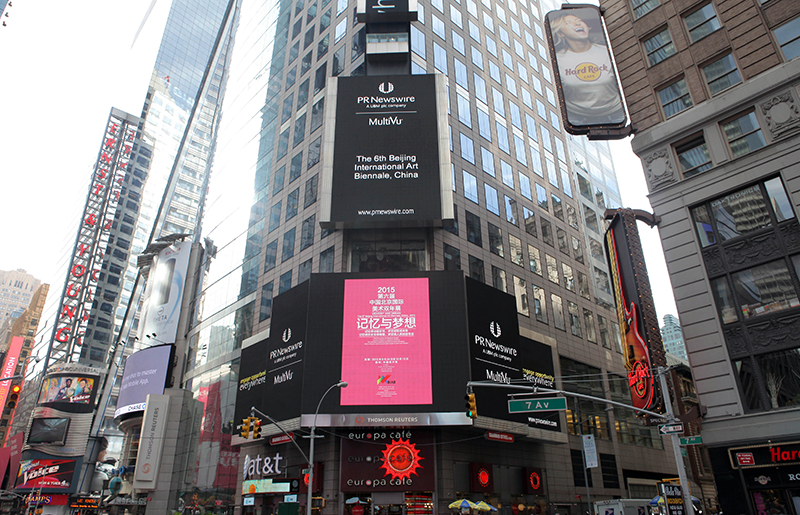
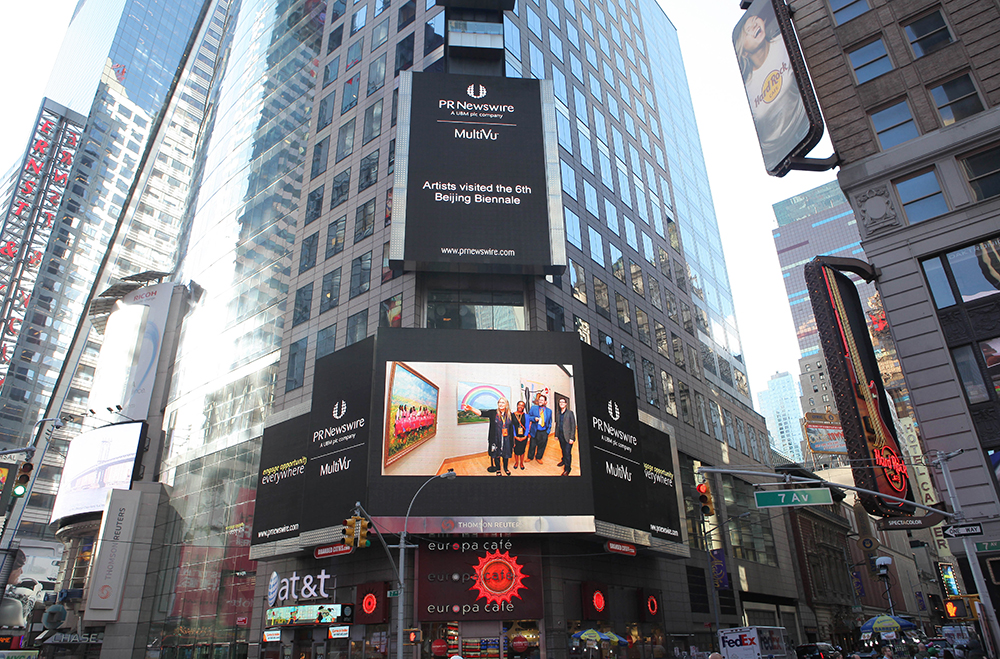
Posters with the theme of the 6th Beijing Biennale appeared on the large screen of the Terminal 3 of the Beijing Capital Airport
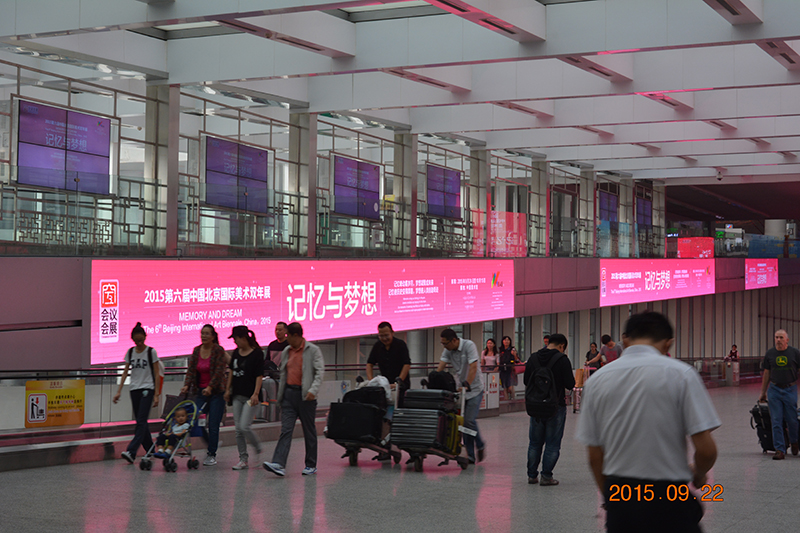
To create a convivial atmosphere, large dynamic public-service advertisement of the Beijing Biennale was set up at the Terminal 3 of the international airport, which is “the busiest airport in the world” and is also a gate to the outside world (from Sep. 23 to Oct. 15) in a bid to improve its social reputation. Participating artists and visitors to China and people far away from here can immediately see the opening of the 6th Beijing International Art Biennale.
The interactive activities left a deep impression of the exhibition
Furthermore, visitors can check out the on-site station “My appointment with ‘Memory and Dream.’” Following the opening ceremony, all the audiences can take a picture with their favorite artwork. Once they fill in a feedback form about the exhibition, the picture can then be made into a postcard to send internationally to friends anywhere in the world. Through the convenient Internet and international postal service, every participant can immediately share the exciting moments about the Beijing Biennale with friends all over the world.
The organizing committee also provided a two-dimension code of some key artworks. After scanning the code, the audience can enjoy the works on their mobile devices at anywhere they like. By means of the internet technology and micro site on the mobile phone, the content including an introduction to the work, pictures and even video can be presented on mobile terminals, which drew people’s attention to the National Art Museum of China on an on-line big show.
An innovative detail needs to be mention here is that: caption of work in both Chinese and English version based on the remarks of the artist can be found on the label of each artwork and in the catalogue, which can help audience from home and abroad to understand the background and philosophy behind artworks.
To give people a chance for an on-the-spot experience after the exhibition, a “3D virtual digital exhibition of the Beijing International Art Biennale in the Smart Art Museum” produced by the China Artists Association and Resource Center of the China Federation of Literary and Art Circles was launched on the Internet on October 14th, which is before the conclusion of the 6th Beijing Biennale, which made the 6th Beijing Biennale a never-ending exhibition. Audience can get a unique virtual experience of visiting the exhibition. It made up for the pity that some audiences couldn’t pay a visit to the exhibition and they can also watch the exhibition on the Internet after the Beijing Biennale.
After the exhibition in a bid to echo with the 6th Beijing Biennale, Mr. Wang Yong, Research Scholar of the Chinese National Academy of Arts and Doctoral Supervisor was invited to deliver a speech on “ From Venice to Beijing: International Art Biennales” at the auditorium of the National Art Museum of China. During the speech, Mr. Wang Yong introduced several long-standing Biennales including La Biennale di Venezia, Sao Paulo Art Biennial and interpreted the orientation of the Beijing Biennale. The Beijing International Art Biennale, founded in 2003, drew experiences from La Biennale di Venezia and Sao Paulo Art Biennial and kept its own curatorial philosophy and features. Now, it has created its own character and become the international center of the contemporary paintings and sculptures. In late November, an on-line virtual exhibition of the Beijing Biennale was promoted on the official website of the National Art Museum of China,which can present the exhibition in its original form on mobile terminals as computers, mobile phones. Everyone can get an on-the-spot experience once they hit the web page. The on-line virtual exhibition is helpful to improve the social awareness of the 6th Beijing Biennale.
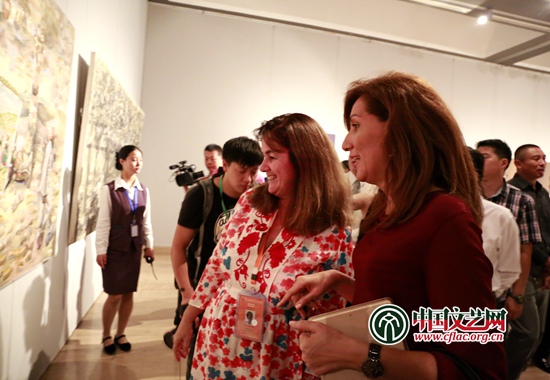
Worldwide Books, an international supplier of catalogues and art books for universities and museums in America, specially inquired whether it can get the catalogue of the 6th Beijing Biennale. Worldwide Books, founded in 1962 in New York, boasts a history of over 50 years. It mainly provides catalogue resources from all over the world for academic institutions, museums and public libraries. The catalogues of La Biennale di Venezia, Istanbul Biennial, Sao Paulo Art Biennial, Biennales de Lyon, Busan Biennale and other world famous Triennales are all included in its collection. This year, the Worldwide Books contacted the organizing committee of the Beijing Biennale to ask for one catalogue soon after they got the information of the exhibition. They were deeply moved by the excellent, exquisite and bilingual in both Chinese and English catalogue. They asked for another 20 catalogues and promised to recommend the catalogue of the Beijing Biennale to the University of Princeton, the Metropolitan Museum of Art, the J. Paul Getty Museum in Los Angeles, the University of Pennsylvania, the Columbia University, the Cornell University, the University of Michigan and 20 other important institutions, which is considered to be a new opportunity for the Beijing Biennale to attract attention from well-known museums and universities around the world.
All in all, the two main parts of the 6th Beijing Biennale, the Theme Exhibition and Special Exhibition,comprehensively presented the latest development in global contemporary paintings and sculptures. It left an impression that there is no boundary in international artistic exchanges and the unlimited possibilities of art creation for artists from all over the world. All these indicated that the philosophy behind the exhibition, the theme, the evaluation and organizing system have won the respect and recognition of artists and relevant institutions from all over the globe.
